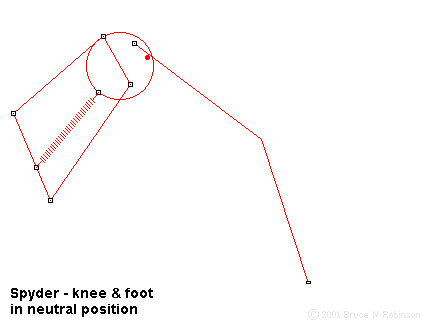BEAM Robotics- based on Nervous Network Technology
|
SEMI-RIGID LINKAGE
You can attach the brass tubes directly to the motor shafts and omit the
springs. Not a problem there.
The spring in the brass tube is a normally compressed spring,( you pull it, it
extends, release it and it contracts again).
Now one end of the spring is connected to the motor output shaft, the whole
thing placed inside the brass tube and the other end of the spring is connected
to the end of the tube.The end of the brass tube housing the spring is soldered to
the respective partof the linkage.The one for the yaw motion is connected to the 4-bar linkage
, and there is another spring thing in the lower link of the 4-bar linkage as well. If you look
carefully, the fixed end(where the spring is soldered to the tube) is also
soldered to a length of thick wire. Together these make up the entire lower linkage.
You can see this in the hi-res pics.
Altogether, it creates a flexible linkage under certain conditions. In normal
operation, the spring remains within the tube and acts as a solid linkage. In
fact,depending on how far the spring is retracted within the brass tube, the
force is directed along the brass tube rather than
MOTORS This robot used 8 (Namiki?) pager motors.These were mated to the OTU geared stage. One could use any geared motor, but changes would have to be made at least to the 4-bar linkage system. The leg mechanics sketches above show such a change.
GEARED STAGE
Spyder uses 8 OTUs as the geared stage of its motors. They are a gearset which one can
salvage from analogue stove timers, electric analogue clocks, dishwashers, and old washing machines.
CHASSIS FRAME
Spyder is built around a square wire frame. Each of the yaw OTUs are soldered to this square's vertices.
The battery is placed in the middle of this frame and a spring stretched between two sides holds it in place.
Other wire sub frames are soldered to this, these include: REPLICA FRAME
A frame will be built from double-sided fibre glass PCB.
It will have a simple geometrical shape, and will use
mortis and tenon locking systems to join structural parts together.
In addition, because the board is copper clad, the joints may be soldered
in place. This means that the frame is both strong, and light. Furthermore, the
inner area of the frame can be filled with another pcb of similar dimension,
[tesselation] . This board will have some of the robot's electronics.
Frame sketches & CAD files:
|
Scale drawings,pdf(2010/08/12)
|
AUTOCAD DWG
|
... |
|||||||||




